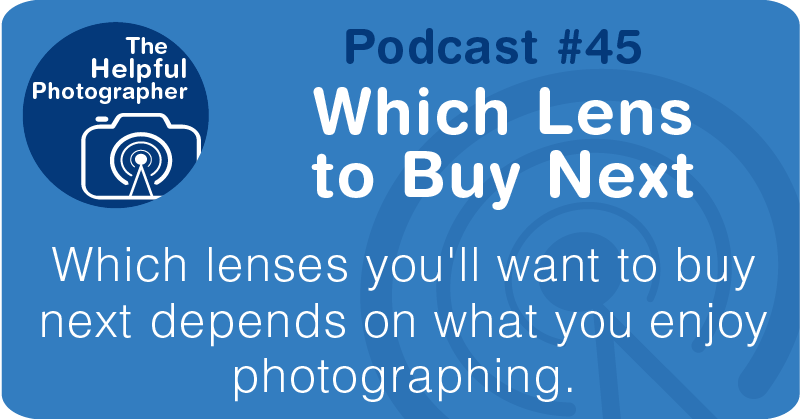Photo Tips Podcast: Which Lens to Buy Next #45

iTunes
Google
Spotify
Tune In
Stitcher
RSS
Pandora
Photo Tips Podcast: Which Lens to Buy Next #45
When you buy a camera with interchangeable lenses it likely came with a medium zoom lens. In other words an 18-55mm or a 24-70mm lens. People often ask, “What should they get next? But, as I often say, “Should is a strong word.” Here are the things you need to consider, for your next lens.
If you find yourself often shooting in situations where your current lens won’t allow you to get back far enough, or you can’t seem to incorporate enough of the scene then you’ll want to add an ultrawide zoom lens to your bag, in addition to the medium kit lens. Something like a 10-24 for crop sensors or 16-35mm for full-frame. This is a great lens for shooting exterior and interior architectural photography, because very often you can’t get back far enough. This is also a great lens for landscapes as you are trying to incorporate more.
On the other hand if you tend to shoot objects that are far in the distance and find that you often can’t get close enough, then you’ll want a long zoom. Something like a 70-200 or a 55-250mm and so on. Of course if you are shooting birds you may consider something even longer than that. On the other hand if you find that you are shooting things that are very close by but the minimum focusing distance on your lens is what’s keeping you from getting closer to your subject then you need a macro lens. Macro lenses usually come in two varieties: 50mm and 100mm. The shorter focal length of the 50mm macro will allow you do things like lay on the ground and shoot up on flowers and navigate tighter spaces. While the 100mm will allow you to stand a little further back away from your subject; very often when shooting macro if you are very close to the subject you may obstruct light or touch things nearby; so the extra focal length of the 100mm lens will give you a little more elbow room to maneuver. It will also give you more compression which is often desirable when shooting macro. Lastly, it should also be noted that the traditional focal length for portraits on a full frame sensor is 105mm, so your macro can double as a great portrait lens especially if you are shooting full frame.
In all of these instances, the question you’ll want to answer is how fast of a lens should you buy? I’m talking about the maximum f/stop. Most zoom lenses will have a variable f/stop. Meaning that your capability will change depending on where you are on the zoom ring. This is usually 3.5-5.6 and relegated to consumer rated lenses. Whereas pro-rated lenses are capable of a fixed aperture throughout the zoom. In other words, no matter where you zoom on the lens you will be able to maintain the same f/stop. Most often pro-rated zoom lenses can hold an f/2.8 throughout the zoom. Although being able to gather up to 2 stops more light is a huge gain, it does come with a cost, both financially and in back pain. These lenses tend to be anywhere from 30 to 60% more expensive than their consumer counterpart. But the much bigger problem is their weight. Which can also be anywhere from 30 to 60% heavier. So the question is whether or not you are willing to carry so much weight around. To be clear, for all of this pain you are not only getting a lens that is gathering more light, you’re likely to get a lens that is sharper, more durable and has faster focus as well. So there are definitely more benefits.
Lastly, what about prime lenses? Too often bloggers out there are recommending the 50mm prime. As a rule, I’m not really into prime lenses for most photographers because they only do one thing. Which makes them very expensive with regards to your wallet and your back. Although most of them are very very sharp and faster, most photographers can’t capitalize on these benefits due to these limitations, so if you can’t capitalize on those benefits then why would you put up with that much pain? If you have the ultra wide, the medium and the long zoom lenses you will pretty much cover all your bases for the vast majority of your shooting. And this is why those three lenses are often dubbed the “Holy Trinity” of lenses. Whether or not you are using the pro version of these lenses your bag will be pretty heavy as it is, so why on earth would you weigh yourself down with a lens that only does one thing? Unless your three lenses doesn’t do that one thing? Like a macro or the 400mm f/2.8?
